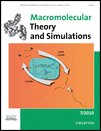Kinetic Simulations of Atom Transfer Radical Polymerization (ATRP) in Light of Chain Length Dependent Termination
Geoffrey Johnston-Hall
Australian Institute for Bioengineering and Nanotechnology, University of Queensland, Brisbane, QLD 4072, Australia
Search for more papers by this authorCorresponding Author
Michael J. Monteiro
Australian Institute for Bioengineering and Nanotechnology, University of Queensland, Brisbane, QLD 4072, Australia
Australian Institute for Bioengineering and Nanotechnology, University of Queensland, Brisbane, QLD 4072, AustraliaSearch for more papers by this authorGeoffrey Johnston-Hall
Australian Institute for Bioengineering and Nanotechnology, University of Queensland, Brisbane, QLD 4072, Australia
Search for more papers by this authorCorresponding Author
Michael J. Monteiro
Australian Institute for Bioengineering and Nanotechnology, University of Queensland, Brisbane, QLD 4072, Australia
Australian Institute for Bioengineering and Nanotechnology, University of Queensland, Brisbane, QLD 4072, AustraliaSearch for more papers by this authorAbstract
Kinetic simulations using the composite kt model allows a better understanding of the effects of the persistent radical affecting ATRP or for that matter any activation–deactivation system. It also provides a better fit to experimental data in either bulk or solution conditions for ATRP polymerizations carried out at 110 °C. The results suggest that the composite model has broad utility over a wide range of experimental conditions and temperatures. The advantage of incorporating an accurate kt model is that one can then use simulations as predictive tool to obtain polymers with higher chain-end fidelity or polymers with low PDI values. This becomes important when attempting to use the chain-ends for further functionalization to make complex polymer architectures. This model can also be used in simulations of miniemulsion or seeded emulsions to determine the effect of compartmentalization with particle size.
References
- 1
- 1a B. E. Daikh, R. G. Finke, J. Am. Chem. Soc. 1992, 114( 8), 2938;
- 1b H. Fischer, Macromolecules 1997, 30, 5666;
- 1c
H. Fischer,
J. Polym. Sci., Part A: Polym. Chem.
1999,
37,
1885.
10.1002/(SICI)1099-0518(19990701)37:13<1885::AID-POLA1>3.0.CO;2-1 CAS Web of Science® Google Scholar
- 2 H. Fischer, Chem. Rev. 2001, 101, 3581.
- 3
- 3a J.-S. Wang, K. Matyjaszewski, Macromolecules 1995, 28, 7901;
- 3b J.-S. Wang, K. Matyjaszewski, Macromolecules 1995, 28, 7572;
- 3c J.-S. Wang, K. Matyjaszewski, J. Am. Chem. Soc. 1995, 117, 5614.
- 4 K. Matyjaszewski, Chem. Rev. 2001, 101, 2921.
- 5 A. Goto, T. Fukuda, Prog. Polym. Sci. 2004, 29, 329.
- 6
- 6a T. Yasukawa, T. Takahashi, K. Murakami, J. Chem. Phys. 1972, 57, 2591;
- 6b T. Yasukawa, K. Murakami, Polymer 1980, 21, 1423;
- 6c O. F. Olaj, G. Zifferer, Macromol. Chem., Rapid Commun. 1982, 3, 549;
- 6d
O. F. Olaj,
P. Vana,
Macromol. Rapid Commun.
1998,
19,
533;
10.1002/(SICI)1521-3927(19981001)19:10<533::AID-MARC533>3.0.CO;2-M CAS Web of Science® Google Scholar
- 6e
O. F. Olaj,
P. Vana,
Macromol. Rapid Commun.
1998,
19,
433;
10.1002/(SICI)1521-3927(19980801)19:8<433::AID-MARC433>3.0.CO;2-G CAS Web of Science® Google Scholar
- 6f M. C. Piton, R. G. Gilbert, B. E. Chapman, P. W. Kuchel, Macromolecules 1993, 26, 4472;
- 6g G. T. Russell, Macromol. Theory Simul. 1994, 3, 439;
- 6h G. T. Russell, R. G. Gilbert, D. H. Napper, Macromolecules 1992, 25, 2459;
- 6i G. T. Russell, R. G. Gilbert, D. H. Napper, 1993, 14, 3538;
- 6j G. T. Russell, R. G. Gilbert, D. H. Napper, Macromolecules 1993, 26, 3538;
- 6h G. T. Russell, D. H. Napper, R. G. Gilbert, Macromolecules 1988, 21, 2133.
- 7 M. C. Griffiths, J. Strauch, M. J. Monteiro, R. G. Gilbert, Macromolecules 1998, 31, 7835.
- 8 D. A. Shipp, K. Matyjaszewski, Macromolecules 1999, 32, 2948.
- 9
- 9a P. Vana, T. P. Davis, C. Barner-Kowollik, Macromol. Rapid Commun. 2002, 23, 952;
- 9b A. Theis, T. P. Davis, M. H. Stenzel, C. Barner-Kowollik, Macromolecules 2005, 38, 10323.
- 10 M. Buback, H. Hippler, J. Schweer, H.-P. Vogele, Makromol. Chem., Rapid Commun. 1986, 7, 261.
- 11
- 11a S. W. Benson, A. M. North, J. Am. Chem. Soc. 1959, 81, 1339;
- 11b S. W. Benson, A. M. North, J. Am. Chem. Soc. 1962, 84, 935.
- 12 G. Johnston-Hall, M. J. Monteiro, Macromolecules 2007, 40, 7171.
- 13 G. Johnston-Hall, M. J. Monteiro, J. Polym. Sci., Part A: Polym. Chem. 2008, 46, 3155.
- 14 G. Johnston-Hall, M. J. Monteiro, Macromolecules 2008, 41, 727.
- 15 G. Johnston-Hall, M. H. Stenzel, T. P. Davis, C. Barner-Kowollik, M. J. Monteiro, Macromolecules 2007, 40, 2730.
- 16 G. Johnston-Hall, A. Theis, M. J. Monteiro, T. P. Davis, M. H. Stenzel, C. Barner-Kowollik, Macromol. Chem. Phys. 2005, 206, 2047.
- 17 C. H. Bamford, H. Tompa, Trans. Faraday Soc. 1954, 50, 1097.
- 18 A. R. Wang, S. Zhu, J. Polym. Sci., Part A: Polym. Chem. 2003, 41, 1553.
- 19 G. B. Smith, G. T. Russell, J. P. A. Heuts, Macromol. Theory Simul. 2003, 12, 299.
- 20
- 20a G. Moad, D. H. Solomon, The Chemistry of Free Radical Polymerization, 1st edition, Pergamon, Oxford 1995;
- 20b J. P. A. Heuts, R. G. Gilbert, L. Radom, Macromolecules 1995, 28, 8771;
- 20c A. A. Gridnev, S. D. Ittell, Macromolecules 1996, 29, 5864;
- 20d O. F. Olaj, P. Vana, M. Zoder, A. Kornherr, G. Zifferer, Macromol. Rapid Commun. 2000, 21, 913.
- 21 M. Buback, R. G. Gilbert, R. A. Hutchinson, B. Klumpermann, F.-D. Kutcha, B. G. Manders, K. O'Driscoll, G. T. Russell, J. Schweer, Macromol. Chem. Phys. 1995, 196, 3267.
- 22 A. W. Hui, A. E. Hamielec, J. Appl. Polym. Sci. 1972, 16, 749.
- 23 J. Brandup, E. H. Immergut, E. A. Grulke, Polymer Handbook, 4th editon;, J. Wiley & Sons, New York 1999.





